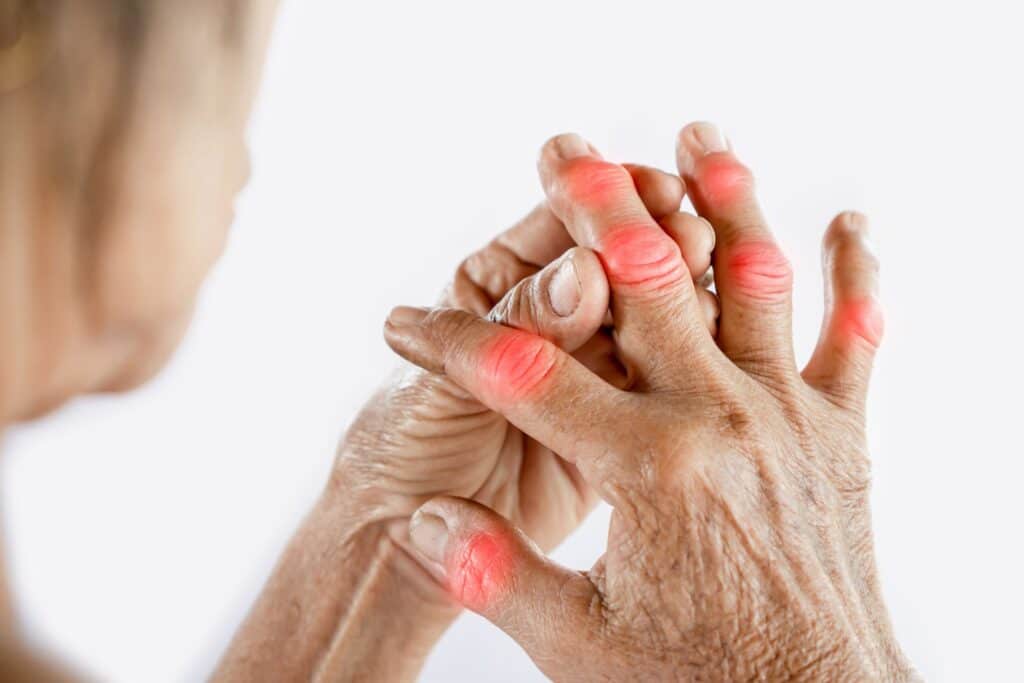Wondering how injections provide relief for hand arthritis?
This article covers how these injections work, by targeting had pain and joint inflammation directly.
The of types of injection available are discussed, along with what to expect.
Key Points
- Injections provide targeted relief for hand arthritis pain by delivering anti-inflammatory substances directly into the affected joints, improving mobility and reducing discomfort.
- Common types of injections include cortisone, hyaluronic acid, and platelet-rich plasma (PRP), each offering distinct benefits and suitable for varying levels of arthritis severity.
- Injections should be considered when conservative treatments fail to alleviate pain, with benefits including immediate relief and improved function.
How injections work to relieve hand arthritis pain
Hand arthritis often results in painful degeneration of cartilage within the joints, leading to significant discomfort and reduced mobility.
Injections offer a targeted approach to manage this pain, delivering anti-inflammatory and analgesic substances directly to the affected area.
This ensures that the medication reaches the precise location where it is needed most, providing immediate and localised relief.
Cortisone injections, for instance, can mimic the body’s natural hormones to reduce inflammation in the joints.
Injecting the medication directly into the joint alleviates pain and stiffness, improving hand function.
The primary goal of these injections is to reduce inflammation and provide pain relief, making it easier for individuals to manage their daily activities without the constant burden to relieve pain.
Whether it’s Rheumatoid Arthritis, Psoriatic Arthritis, or Osteoarthritis, Joint Injections can be a crucial part of a comprehensive treatment plan to manage symptoms and improve quality of life.
Types of injections for hand arthritis
There are several types of injections used to treat hand arthritis, each offering unique benefits and considerations.
Cortisone injections, Hyaluronic acid injections, and Platelet-Rich Plasma (PRP) injections are among the most common options.
Understanding their differences can help you and your healthcare provider choose the best treatment for your specific condition.
Cortisone injections
Cortisone injections are a widely used treatment for reducing inflammation and providing pain relief in arthritis-affected joints. These injections also known as Steroid injections mimic the body’s natural hormones to reduce inflammation and alleviate pain and stiffness in the joint.
They are especially effective in providing immediate pain relief, often within a few days of administration, and can be particularly beneficial for those experiencing severe discomfort.
Cortisone injections can delay the need for more invasive treatments like hand surgery, offering temporary but significant relief from symptoms.
However, the relief provided by Cortisone injections is typically temporary, lasting anywhere from a few months to six months, depending on the individual and the severity of their arthritis.
Each subsequent injection may be less effective, and overuse of Cortisone Injections is discouraged
Despite these limitations, Cortisone Injections remain a popular choice for those needing fast, temporary relief from arthritis pain.
They can be an essential part of a broader treatment plan, helping to manage symptoms while other long-term treatments take effect.
Hyaluronic acid injections
Hyaluronic acid injections are another option for treating hand arthritis, particularly osteoarthritis.
Hyaluronic acid acts as a lubricating substance within the joints, helping to reduce pain and improve mobility.
When injected directly into the joint, it enhances the viscosity of the joint fluid, which can alleviate the pain and stiffness associated with moderate arthritis.
These injections are particularly useful for individuals whose arthritis pain is due to the loss of cartilage and joint lubrication.
By restoring some of the joint’s natural lubrication, hyaluronic acid injections improve range of motion and reduce friction, alleviating arthritis symptoms.
Platelet-Rich plasma (PRP) injections
Platelet-rich plasma (PRP) injections represent a more innovative approach to treating hand arthritis.
PRP is derived from the patient’s own blood, which is processed to concentrate the platelets and growth factors that promote healing.
This concentrated plasma is then injected directly into the affected joint, where it can help reduce inflammation and stimulate tissue repair.
Doctors often recommend PRP injections for patients looking to avoid surgery and those who have not had success with other treatments.
The use of the patient’s own blood minimises the risk of adverse reactions and utilises the body’s own proteins and growth factors to help alleviate arthritis symptoms.
When to consider injections for hand arthritis
Injections for hand arthritis should be considered when conservative treatments such as oral medications, physical therapy, or lifestyle changes fail to provide sufficient relief to treat arthritis.
The severity of joint pain and inflammation plays a crucial role in this decision.
If you find that your arthritis pain significantly affects your daily activities and other treatments are proving less and less effective or are intolerable as in the case of medications, injections might be a suitable option.
Injections can offer targeted pain relief, making them an attractive choice for those with severe symptoms.
Discussing your symptoms and treatment history with a healthcare provider will help determine if injections are the right step for managing your hand arthritis.
Benefits and risks of injections for hand arthritis
The benefits of injections for hand arthritis are numerous.
They can provide fast acting pain relief.
This immediate relief is crucial for managing severe pain while waiting for longer-term treatments to take effect.
Injections like hyaluronic acid can also help improve joint function by restoring lubrication and reducing stiffness.
However, there are risks associated with these treatments.
Mild soreness at the injection site is common, and there is a risk of infection, particularly with repeated Cortisone injections.
Additionally, the relief provided by injections is often temporary, and repeated treatments may be necessary.
A thorough discussion with your clinician before proceeding with injections is important. This conversation will help you make an informed decision that aligns with your treatment goals and overall health.
Post-injection care and what to expect
After receiving an injection, post-injection care is crucial to ensure the best possible outcome.
Patients are often advised to rest the treated area and avoid strenuous activities for a few days to allow the medication to take full effect.
Monitoring how the injection affects your symptoms is also important, as it can provide valuable feedback for your healthcare provider.
Potential risks include infection, so following specific instructions from your healthcare provider such as not washing the affected ted area for 24 hrs post injection and avoiding swimming or sauna for 48 hrs is crucial.
Comparing injections with other treatment options
When comparing injections with other treatment options for hand arthritis, several factors must be considered.
Cortisone injections are the most frequently used option for alleviating pain in hand joints.
They offer quick relief, making them suitable for patients needing immediate management of severe symptoms.
On the other hand, treatments like splinting and oral medications provide more gradual benefits and are often used in conjunction with injections for a comprehensive approach.
Hyaluronic acid injections are believed to restore joint fluid viscosity, which can alleviate arthritis pain, though their effectiveness varies among individuals.
Studies on the effectiveness of PRP injections for hand arthritis are ongoing, with some showing potential benefits.
These injections offer a more natural approach by using the patient’s own blood to promote healing.
In contrast, surgery is usually recommended for severe cases when other treatments fail, but it involves longer recovery times compared to injections.
Insert Pic here
For example in the picture above, a steroid injection into the Scaphoid Trapezio Trapezoid Complex is a temporary fix and risks damaging the tendon close to it (Flexor Carpi Radialis Tendon-responsible for flexing the wrist).
To further complicate matters the STT arthritis itself risks also damaging the FCR tendon. In this situation and orthopaedic opinion is crucial to prevent complications
Ultimately, the choice of treatment depends on the severity of symptoms, the patient’s overall health, and specific treatment goals.
Consulting with a Doctor or Orthopaedic Specialist can help determine the most appropriate approach for managing hand arthritis.
Hand Arthritis Injections: Summary
Injections offer a valuable option for managing hand arthritis pain, providing immediate and targeted relief when other treatments fall short.
From Cortisone to Hyaluronic Acid and PRP injections, each type has unique benefits and considerations.
Understanding when to consider injections and being aware of the potential risks can help you make informed decisions about your treatment plan.
While injections can provide significant relief, they are often part of a broader strategy that includes other treatments.
Discussing your options with a specialist will ensure that you receive the most effective and personalised care for your hand arthritis.
Researching and stay proactive in managing your condition can help maintain your quality of life.
Frequently Asked Questions
What types of injections are available for hand arthritis?
Cortisone, Hyaluronic acid, and Platelet-rich plasma (PRP) injections are common options available for treating hand arthritis.
Each type aims to reduce pain and improve function in the affected joints.
How do Cortisone Injections work for Hand Arthritis?
Cortisone injections provide immediate pain relief and reduce inflammation by delivering anti-inflammatory medication directly into the affected joint, effectively managing symptoms of hand arthritis.
When should I consider getting injections for hand arthritis?
You should consider getting injections for hand arthritis if you experience severe joint pain and inflammation that remain unrelieved by conservative treatments such as oral medications or physical therapy.
What are the risks associated with injections for hand arthritis?
The risks associated with injections for hand arthritis include mild soreness at the injection site, potential infection, and the likelihood of requiring repeated treatments as the effects diminish. It is essential to consider these factors when evaluating treatment options.
How do injections compare with other treatment options for hand arthritis?
Injections provide rapid relief for hand arthritis symptoms, making them a preferred option for immediate management, whereas treatments like splinting and surgery vary in benefits and recovery duration.





